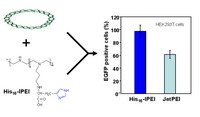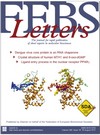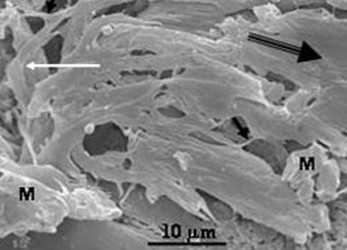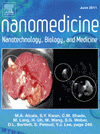
Supramolecular assemblies of Histidinylated α-cyclodextrin in the presence of DNA scaffold during CDplexes formation.
Celton V, Urbach A, Martin OR, Pichon C, Guegan P, Midoux P.
Bioconjug Chem. 2011 Oct 21. [Epub ahead of print]

Supramolecular assemblies of Histidinylated α-cyclodextrin in the presence of DNA scaffold during CDplexes formation.
Celton V, Urbach A, Martin OR, Pichon C, Guegan P, Midoux P.
Bioconjug Chem. 2011 Oct 21. [Epub ahead of print]

Histidinylated linear PEI: a new efficient non-toxic polymer for gene
transfer
Bertrand E, Gonçalves C, Billiet L, Gomez JP, Pichon C, Cheradame H, Midoux P,
Guégan P.
Chem Commun (Camb). 2011 Oct 24. [Epub ahead of print]

Titre : Optimizing Sensitization Processes in Dinuclear Luminescent Lanthanide Oligomers: Selection of Rigid Aromatic Spacers
Références : J. Am. Chem. Soc., 2011, 133 (40), pp 16219–16234
Auteurs : Jean-François Lemonnier, Laure Guénée, César Beuchat, Tomasz A. Wesolowski, Prasun Mukherjee, David H. Waldeck, Kristy A. Gogick, Stéphane Petoud and Claude Piguet
DOI: 10.1021/ja206806t
Accès pour abonnés portail BiblioVie
Résumé :
This work illustrates a simple approach for optimizing the lanthanide luminescence in molecular dinuclear lanthanide complexes and identifies a particular multidentate europium complex as the best candidate for further incorporation into polymeric materials. The central phenyl ring in the bis-tridentate model ligands L3–L5, which are substituted with neutral (X = H, L3), electron-withdrawing (X = F, L4), or electron-donating (X = OCH3, L5) groups, separates the 2,6-bis(benzimidazol-2-yl)pyridine binding units of linear oligomeric multi-tridentate ligand strands that are designed for the complexation of luminescent trivalent lanthanides, Ln(III). Reactions of L3–L5 with [Ln(hfac)3(diglyme)] (hfac– is the hexafluoroacetylacetonate anion) produce saturated single-stranded dumbbell-shaped complexes [Ln2(Lk)(hfac)6] (k = 3–5), in which the lanthanide ions of the two nine-coordinate neutral [N3Ln(hfac)3] units are separated by 12–14 Å. The thermodynamic affinities of [Ln(hfac)3] for the tridentate binding sites in L3–L5 are average (6.6 ≤ log(β2,1Y,Lk) ≤ 8.4) but still result in 15–30% dissociation at millimolar concentrations in acetonitrile. In addition to the empirical solubility trend found in organic solvents (L4 > L3 L5), which suggests that the 1,4-difluorophenyl spacer in L4 is preferable, we have developed a novel tool for deciphering the photophysical sensitization processes operating in [Eu2(Lk)(hfac)6]. A simple interpretation of the complete set of rate constants characterizing the energy migration mechanisms provides straightforward objective criteria for the selection of [Eu2(L4)(hfac)6] as the most promising building block.

Il a également été choisi comme couverture de cette édition.
Samia Aci-Sèche, Monique Genest, Norbert Garnier
Ligand entry pathways in the ligand binding domain of PPARγ receptor
FEBS Letters – 585 (16) 2599-2603 – doi : 10.1016/j.febslet.2011.07.014
Résumé :
To address the question of ligand entry process, we report targeted molecular dynamics simulations of the entry of the flexible ionic ligand GW0072 in the ligand binding domain of the nuclear receptor PPARγ. Starting with the ligand outside the receptor the simulations led to a ligand docked inside the binding pocket resulting in a structure very close to the holo-form of the complex. The results showed that entry process is guided by hydrophobic interactions and that entry pathways are very similar to exit pathways. We suggest that TMD method may help in discriminating between ligands generated by in silico docking.

Frances Westall, Directrice de Recherche CNRS, responsable de l’équipe « Exobiologie » vient de rapporter la découverte d’une preuve de l’existence d’un mécanisme de photosynthèse datant de 3,3 milliards d’années au sein de biofilms de microorganismes.
Ces résultats ont été présentés durant le congrès « Origins 2001 » à Montpellier.
Le site « Nature News » a fait état de cette découverte dans sa « une », soulignant ainsi son importance.

The filamentous remnants of microbes in ancient microbial mats are evidence that photosynthesis was happening 3.3 billion years ago.
Frances Westall

Le lien vers la page de couverture est : http://www.nanomedjournal.com/ dans la rubrique « On the cover ».
Le lien vers l’article est (accès gratuit au PDF) : http://www.nanomedjournal.com/article/PIIS1549963410002972/fulltext